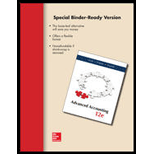
Advanced Accounting (Looseleaf)
12th Edition
ISBN: 9780077632595
Author: Hoyle
Publisher: MCG
expand_more
expand_more
format_list_bulleted
Concept explainers
Question
Chapter 3, Problem 2P
To determine
Identify the appropriate answer for the given statement from the given choices.
Expert Solution & Answer
Trending nowThis is a popular solution!

Students have asked these similar questions
Provide Answer
Calculate the direct labor rate variance of the above information
Solve this Accounting MCQ
Chapter 3 Solutions
Advanced Accounting (Looseleaf)
Ch. 3 - Prob. 1QCh. 3 - Prob. 2QCh. 3 - Prob. 3QCh. 3 - Prob. 4QCh. 3 - When a parent company applies the initial value...Ch. 3 - Several years ago, Jenkins Company acquired a...Ch. 3 - Benns adopts the equity method for its 100 percent...Ch. 3 - Prob. 8QCh. 3 - Prob. 9QCh. 3 - Prob. 10Q
Ch. 3 - Prob. 11QCh. 3 - Prob. 12QCh. 3 - Prob. 1PCh. 3 - Prob. 2PCh. 3 - Prob. 3PCh. 3 - Prob. 4PCh. 3 - Prob. 5PCh. 3 - Prob. 6PCh. 3 - If no legal, regulatory, contractual, competitive,...Ch. 3 - Prob. 8PCh. 3 - Prob. 9PCh. 3 - Prob. 10PCh. 3 - Prob. 11PCh. 3 - Prob. 12PCh. 3 - Prob. 13PCh. 3 - Prob. 14PCh. 3 - Prob. 15PCh. 3 - Prob. 16PCh. 3 - Prob. 17PCh. 3 - Prob. 18PCh. 3 - Prob. 19PCh. 3 - Prob. 20PCh. 3 - Prob. 21PCh. 3 - Prob. 22PCh. 3 - Prob. 23PCh. 3 - Prob. 24PCh. 3 - Prob. 25PCh. 3 - Prob. 26PCh. 3 - Prob. 27PCh. 3 - Prob. 28PCh. 3 - Prob. 29PCh. 3 - Prob. 30PCh. 3 - Prob. 31PCh. 3 - 32. Following are selected accounts for...Ch. 3 - Prob. 33PCh. 3 - Prob. 34PCh. 3 - Prob. 35PCh. 3 - Prob. 36PCh. 3 - Prob. 37PCh. 3 - Prob. 38PCh. 3 - Prob. 1DYSCh. 3 - FASB ASC AND IASB RESEARCH CASE A vice president...Ch. 3 - Prob. 4DYSCh. 3 - Prob. 5DYS
Knowledge Booster
Learn more about
Need a deep-dive on the concept behind this application? Look no further. Learn more about this topic, accounting and related others by exploring similar questions and additional content below.Similar questions
- I need help with this general accounting question using standard accounting techniques.arrow_forwardElegant Furnishings earned net sales revenue of $42,375,000 in 2023. The cost of goods sold was $29,662,500, and net income reached $7,800,000, the company's highest ever. Compute the company's gross profit percentage for 2023.arrow_forwardDepreciation is classified as a(n):a) Assetb) Expensec) Liabilityd) Revenuearrow_forward
- Strudel Company reported 2008 sales ($ in millions) of $4,825 and a cost of goods sold of $3,560. The company uses the LIFO method for inventory valuation. It discloses that if the FIFO inventory valuation method had been used, inventories would have been $86.3 million and $71.8 million higher in 2008 and 2007, respectively. If Strudel used the FIFO method exclusively, it would have reported 2008 gross profit closest to? A. $1,265.0 million B. $1,279.5 million C. $1,351.3 millionarrow_forwardCould you help me solve this financial accounting question using appropriate calculation technical.arrow_forward5 POINTSarrow_forward
- What is the total contribution margin ?arrow_forwardGriffin Manufacturing reported an unadjusted cost of goods sold (COGS) of $105,000 for the year 20X2. During the year, the company experienced several variances, including a $6,000 unfavorable direct labor efficiency variance, a $2,500 favorable direct labor rate variance, a $5,500 unfavorable direct materials price variance, and a $4,000 unfavorable direct materials usage variance. There were no overhead variances reported. Based on this information, what is Griffin Manufacturing’s adjusted cost of goods sold for 20X2?arrow_forwardPlease explain the solution to this general accounting problem using the correct accounting principles.arrow_forward
arrow_back_ios
SEE MORE QUESTIONS
arrow_forward_ios
Recommended textbooks for you
 Financial Reporting, Financial Statement Analysis...FinanceISBN:9781285190907Author:James M. Wahlen, Stephen P. Baginski, Mark BradshawPublisher:Cengage Learning
Financial Reporting, Financial Statement Analysis...FinanceISBN:9781285190907Author:James M. Wahlen, Stephen P. Baginski, Mark BradshawPublisher:Cengage Learning Auditing: A Risk Based-Approach to Conducting a Q...AccountingISBN:9781305080577Author:Karla M Johnstone, Audrey A. Gramling, Larry E. RittenbergPublisher:South-Western College Pub
Auditing: A Risk Based-Approach to Conducting a Q...AccountingISBN:9781305080577Author:Karla M Johnstone, Audrey A. Gramling, Larry E. RittenbergPublisher:South-Western College Pub Auditing: A Risk Based-Approach (MindTap Course L...AccountingISBN:9781337619455Author:Karla M Johnstone, Audrey A. Gramling, Larry E. RittenbergPublisher:Cengage Learning
Auditing: A Risk Based-Approach (MindTap Course L...AccountingISBN:9781337619455Author:Karla M Johnstone, Audrey A. Gramling, Larry E. RittenbergPublisher:Cengage Learning


Financial Reporting, Financial Statement Analysis...
Finance
ISBN:9781285190907
Author:James M. Wahlen, Stephen P. Baginski, Mark Bradshaw
Publisher:Cengage Learning

Auditing: A Risk Based-Approach to Conducting a Q...
Accounting
ISBN:9781305080577
Author:Karla M Johnstone, Audrey A. Gramling, Larry E. Rittenberg
Publisher:South-Western College Pub

Auditing: A Risk Based-Approach (MindTap Course L...
Accounting
ISBN:9781337619455
Author:Karla M Johnstone, Audrey A. Gramling, Larry E. Rittenberg
Publisher:Cengage Learning